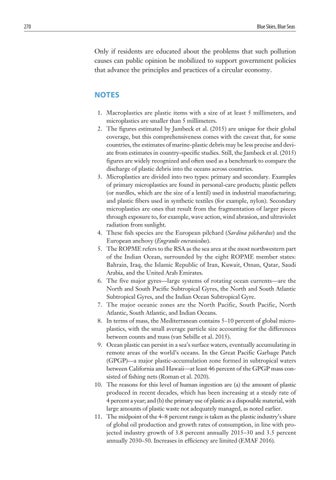270
Blue Skies, Blue Seas
Only if residents are educated about the problems that such pollution causes can public opinion be mobilized to support government policies that advance the principles and practices of a circular economy.
NOTES 1. Macroplastics are plastic items with a size of at least 5 millimeters, and microplastics are smaller than 5 millimeters. 2. The figures estimated by Jambeck et al. (2015) are unique for their global coverage, but this comprehensiveness comes with the caveat that, for some countries, the estimates of marine-plastic debris may be less precise and deviate from estimates in country-specific studies. Still, the Jambeck et al. (2015) figures are widely recognized and often used as a benchmark to compare the discharge of plastic debris into the oceans across countries. 3. Microplastics are divided into two types: primary and secondary. Examples of primary microplastics are found in personal-care products; plastic pellets (or nurdles, which are the size of a lentil) used in industrial manufacturing; and plastic fibers used in synthetic textiles (for example, nylon). Secondary microplastics are ones that result from the fragmentation of larger pieces through exposure to, for example, wave action, wind abrasion, and ultraviolet radiation from sunlight. 4. These fish species are the European pilchard (Sardina pilchardus) and the European anchovy (Engraulis encrasicolus). 5. The ROPME refers to the RSA as the sea area at the most northwestern part of the Indian Ocean, surrounded by the eight ROPME member states: Bahrain, Iraq, the Islamic Republic of Iran, Kuwait, Oman, Qatar, Saudi Arabia, and the United Arab Emirates. 6. The five major gyres—large systems of rotating ocean currents—are the North and South Pacific Subtropical Gyres, the North and South Atlantic Subtropical Gyres, and the Indian Ocean Subtropical Gyre. 7. The major oceanic zones are the North Pacific, South Pacific, North Atlantic, South Atlantic, and Indian Oceans. 8. In terms of mass, the Mediterranean contains 5–10 percent of global microplastics, with the small average particle size accounting for the differences between counts and mass (van Sebille et al. 2015). 9. Ocean plastic can persist in a sea’s surface waters, eventually accumulating in remote areas of the world’s oceans. In the Great Pacific Garbage Patch (GPGP)—a major plastic-accumulation zone formed in subtropical waters between California and Hawaii—at least 46 percent of the GPGP mass consisted of fishing nets (Roman et al. 2020). 10. The reasons for this level of human ingestion are (a) the amount of plastic produced in recent decades, which has been increasing at a steady rate of 4 percent a year; and (b) the primary use of plastic as a disposable material, with large amounts of plastic waste not adequately managed, as noted earlier. 11. The midpoint of the 4–8 percent range is taken as the plastic industry’s share of global oil production and growth rates of consumption, in line with projected industry growth of 3.8 percent annually 2015–30 and 3.5 percent annually 2030–50. Increases in efficiency are limited (EMAF 2016).






